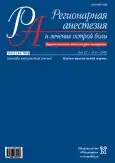Experience of appllication of the bilateral suprazygomatic maxillary nerve block for cleft palate repair in children
- 作者: Dubinenkov V.B.1, Bessonov S.N.2, Voitsekhovsky I.S.3, Ganert A.N.2
-
隶属关系:
- Clinic Constanta LLC
- Yaroslavl State Medical University
- The Russian branch of the international mission «Operation Smile»
- 期: 卷 12, 编号 4 (2018)
- 页面: 227-230
- 栏目: Original articles
- URL: https://journals.rcsi.science/1993-6508/article/view/61293
- DOI: https://doi.org/10.17816/1993-6508-2018-12-4-227-230
- ID: 61293
如何引用文章
全文:
详细
The aim of the study was to determine the efficacy and safety of the bilateral suprazygomatic maxillary nerve block for cleft palate repair in children with congenital malformation, cleft palate. The study was carried out on 55 patients with primary cleft palate repair. The average age of the patients was 1 year 8 months±6 months. Patients were divided into 2 groups. In the main group, general anesthesia, local anesthesia and bilateral suprazygomatic maxillary nerve block were performed. In the control group, general anesthesia and local anesthesia were performed. The severity of the pain syndrome in children was assessed according to the FLACC scale. In addition, the dose opioid analgesics (tramadol) was taken into account on the 1st day; satisfaction with anesthesia and analgesia. Results for the main group: FLACC indicators were kept longer at a low level; less consumption of opioid analgesics. No complications were observed on the bilateral suprazygomatic maxillary nerve block. The bilateral suprazygomatic maxillary nerve block for primary cleft palate repair in children provides a better quality of anesthesia, and, especially postoperative analgesia.
作者简介
Vladimir Dubinenkov
Clinic Constanta LLC
编辑信件的主要联系方式.
Email: 63vbd@mail.ru
anesthesiologist-resuscitator
俄罗斯联邦, YaroslavlS. Bessonov
Yaroslavl State Medical University
Email: 63vbd@mail.ru
俄罗斯联邦, Yaroslavl
I. Voitsekhovsky
The Russian branch of the international mission «Operation Smile»
Email: 63vbd@mail.ru
俄罗斯联邦, Yaroslavl
A. Ganert
Yaroslavl State Medical University
Email: 63vbd@mail.ru
俄罗斯联邦, Yaroslavl
参考
- Ovechkin A.M., Sviridov S.V. Postoperative pain and pain relief: current state of the problem. Regionarnaya anesteziya i lechenie ostroy boli. 2006; 1(0): 61–75. (in Russian)
- Ayzenberg V.L., Ul’rikh G.E., Tsypin L.E., Zabolotskiy D.V. Separate chapters from the monograph “Regional Anesthesia in Pediatrics.” Extended peripheral and central blockades in the postoperative period. Regionarnaya anesteziya i lechenie ostroy boli. 2014; 7(4): 41–9. (in Russian)
- Mesnil M., Dadure C., Captier G., Raux O., Rochette A., Canaud N., Sauter M. A new approach for peri-operative analgesia of cleft palate repair in infants: the bilateral suprazygomatic maxillary nerve block. Paediatr. Anaesth. 2010; 20(4): 343–349.
- Chiono J., Raux O., Bringuier S., Sola C., Bigorre M., Capdevila X. Bilateral suprazygomatic maxillary nerve block for cleft palate repair in children. Anesthesiology. 2014; 120: 1362–9.
- Dmitriev D.V., Kotikov A.V., Layko L.I. Vzhetsoni E.E. Methods for pain assessment in different ages children. Dytjachyj lykar. 2015; 1(38): 8–13. (in Russian)
- Evaluation and management of pain in children. A brief course of computer training, including the recommendations of the WHO 2012 on pain relief. M.:R.Valent; 2014. (in Russian)
- Neal J.M., Bernards C.M., Butterworth J.F., Di Gregorio G., Drasner K., Hejtmanek M.R., Mulroy M.F., Rosenquist R.W., Weinberg G.L. ASRA practice advisory on local anesthetic systemic toxicity. Reg. Anesth. Pain Med. 2010; 35(2): 152–61.
补充文件






